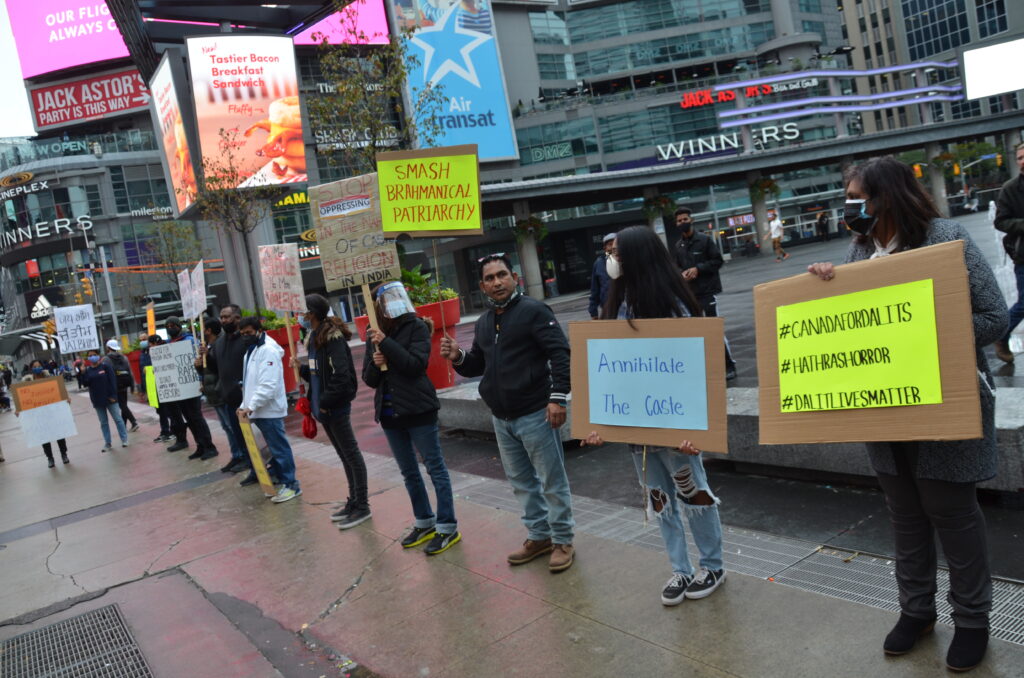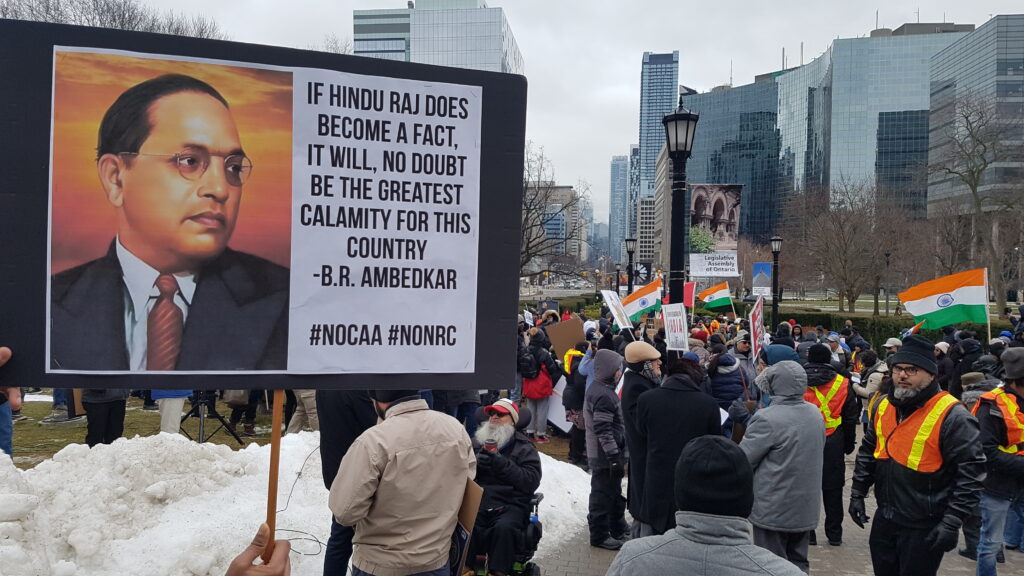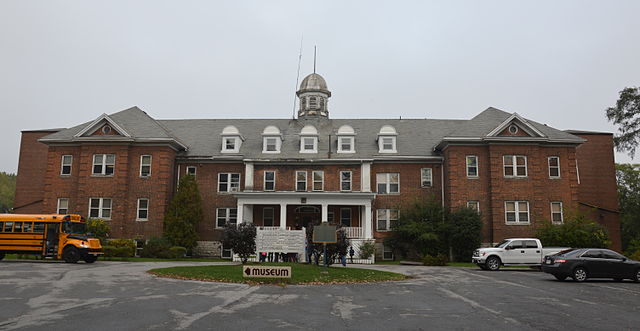By Vijay Puli, Ramchandran J., Sailaja Krishnamurti, Aparna Sundar, and Vasanthi Venkatesh
While Dalits and caste-oppressed people around the world are celebrating Dalit History Month this April, we need to reflect on the challenges Dalits have faced in the last year, especially from the dominant-caste Hindu nationalists who have been working fearlessly in Canadian society under the name of multiculturalism for so long.
In 2023, they launched a petition (e-4507) demanding that the federal government explicitly recognize “Hinduphobia” in the Human Rights Code” to include any “denial, negation, prejudice or vilification against Hindus, Hinduism, or Hinduness”. The petition claimed that “Hindus in Canada face growing negative stereotyping, prejudice, and discrimination at work, in schools and in the communities.” Despite little evidence that anti-Hindu views are rising among Canadians, galvanized by Canada’s recent diplomatic crisis with India, they engaged in dog-whistle politics to spread rumours that Hindu Indians in Canada are being targeted for harassment. It is critical that we closely examine these claims of Hinduphobia as they have been used to violently and insidiously attack caste-oppressed communities.
Dalit and other organizations successfully organized to oppose the petition, showing that the demand for the recognition of “Hinduphobia” was simply a way of thwarting demands for caste equality and legitimate criticisms of the current Indian regime. Indeed, the Minister of Diversity and Inclusion and Persons with Disabilities rightly declined to consider drafting a bill on Hinduphobia, pointing out that Canada’s government already “unequivocally rejects all forms of hate and discrimination.”
But the allegations of Hinduphobia to undermine demands for caste equality persist. In an article about the petition published in New Canadian Media, Ragini Sharma and Vijaykumar Jain from the Canadian Organization for Hindu Heritage Education (COHHE) not only refused to admit that practices of caste oppression were part of the Hindu religion, they alleged that even seeking “caste as a protected class status” was Hinduphobia. Even after the Ontario Human Rights Commission explicitly asserted that caste-based discrimination is covered under the Ontario Human Rights code in a path-breaking policy that recognized the intersectional nature of caste oppression, Dr. Sharma made the same allegation before the Mississauga City Council, singling out the South Asian Dalit Adivasi Network (SADAN) as an organization the council had to target. SADAN is a secular organization run by volunteers from caste-oppressed backgrounds representing caste-oppressed folks living in Canada, particularly Ontario. Its members are from Dalit (who are deemed “untouchables”) and Adivasi (a term used to describe Indigenous tribal populations in South Asia, who have been ostracized and oppressed as being “uncivilized”) communities who have faced the brunt of caste oppression, and who are now living in Canada, hoping to be free from it.

It is not at all surprising to see that dominant-caste Hindus either in India or in Canada refuse to admit the truth about caste oppression. The caste system originated from notions of purity and pollution in the Hindu religion, and was prescribed in many Hindu texts, including the Purusha-Sukta, Manusmriti, and Bhagavad Gita.
Caste is practiced by dominant-caste Hindus in Canada in many ways. Only caste-oppressed people can feel the force of that discrimination and pain. For example, only upper-caste Hindu men can perform certain rituals or serve deities in temples, a practice that can be seen in many Canadian Hindu communities. Caste connections determine marriage arrangements and business alliances. We can see matrimonial ads where dominant-caste Hindus ask for a bride or groom only from their caste. Caste-oppressed individuals are denied housing by South Asian landlords due to their caste identity. Children are bullied on school premises due to their caste. Discrimination and untouchability based on Dalit food habits are practiced in the community. In fact, the consumption of beef, an essential element of Dalit and Adivasi food culture, is excluded from South Asian events in institutions and social gatherings. This is casteism without condemnation by anyone. Traditional Hindu festivals like Diwali, Dasara, and Holi actually celebrate violence against oppressed-caste people; Dalit and Adivasi tribes observe those festivals to mourn their Asura ancestors who were killed by Aryan Hindu gods. Historically, the practice of yoga is associated with dominant-caste Hindus and excluded caste-oppressed communities. The entire concept of yoga promotes the Brahamanic casteist notions of purity, vegetarianism, and the theory of Karma and rebirth that justifies the plight of oppressed castes who are born low due to their deeds in their previous lives.
Savarnas (caste-privileged Hindus) who are campaigning about Hinduphobia often quote racial justice champions like Martin Luther King and Nelson Mandela and project themselves as activists, but they ignore the anti-caste work of reformers like Dr. B R. Ambedkar, Jyotiba Phule, Savitribhai Phule, Periyar Ramasamy, Fatima Sheikh, Ayyankali, and Iyothee Thass, leaders who worked their entire lives to fight against caste oppression in South Asia.
Dr. Ambedkar, who spent his whole life researching caste oppression and authored many books, wrote: “Hindu society is a myth…Hindu society as such does not exist. It is only a collection of Castes.” In a 1936 speech, Dr. Ambedkar stated that “Caste is a state of mind. It is a disease of the mind. The teachings of the Hindu religion are the root cause of this disease. We practice casteism, we observe untouchability, because we are asked to do so by the Hindu religion in which we live.” He also publicly burnt the Hindu law book, the Manusmriti, on December 25, 1927; that day is now referred to as “Manusmriti Dahan Divas,” and is a symbol of rejection of the religious basis of untouchability.

Another anti-caste reformer, Periyar Ramaswamy, denounced Hindu festivals as the imposition of Brahmanic Aryan traditions over the caste-oppressed and Dravidian people. One example is “Ram Leela,” which is celebrated during Diwali season and symbolizes the “victory” of Ram (representing Aryans) over Ravan (representing the Dravidians and caste-oppressed people). Periyar called on people to celebrate Ravan Leela instead, in opposition to this tradition and to acknowledge caste oppression. The ongoing popularity of Ram Leela and the slogan “victory of light over dark” that is associated with the Diwali season actually represents this casteist and racist practice.
Despite the work of these social reformers, the caste system remains strong in India and across South Asia. Caste has permeated across all religious communities in South Asia, including Muslims, Christians, Sikhs, and others. It is also deeply rooted in patriarchy and heteronormative practices. And it is not left behind when immigrants make a new home in North America. According to even the most conservative estimates, 25% of Indians are Dalits and Adivasis and there are over at least 1.8 million people of Indian descent in Canada (over 2.3 million South Asians). Is challenging casteist practices equivalent to Hinduphobia? Is this concept actually being used to silence anti-caste activists?
There are a few points that Hindus in Canada, and all Canadians, should know before supporting campaigns about Hinduphobia.
Hindus may experience racism, but that does not amount to widespread “Hinduphobia.” South Asians in Canada have been targets of racism in many ways that have been documented in the press. But there is actually little evidence showing systemic, structural, or state-sponsored harms against Hindus in Canada that explicitly target Hindu beliefs. In fact, the state and several institutions promote Hindu festivals and beliefs under the banner of multiculturalism in Canada. November has even been federally designated as “Hindu Heritage Month.” Politicians at all levels routinely make appearances at Hindu religious events. In Peel Region, which has a significant South Asian population, Peel police have gone out of their way to embrace dominant-caste Hindu festivals with organizations like the Hindu Swayamsevak Sangh (HSS) that have links to the Hindu supremacist paramilitary organization, the Rashtriya Swayamsevak Sangh (RSS). Many of the festivals degrade/dehumanize women and caste-oppressed people, such as the festival of Karwa Chauth where a woman is required to fast for the long life of her husband. This shows how Hinduism has been integrated into public services in Canada, contrary to the claims in the petition.
Attacks on temples have been cited as evidence of “Hinduphobia.” However, there is no perpetrator identified by the police so far to prove that they are motivated by Hinduphobia. While these might be projected as anti-Hindu actions, this is not the same as the kind of “Hinduphobia” that the petition describes because these are not acts of hate rooted in historical systems of power.
This campaign is intended to silence caste equity activists. The Hinduphobia campaign has been strategically deployed by Hindu supremacist organizations to counter the widespread support for new policies challenging caste-based discrimination in Canada. Canadians from oppressed-caste communities are finally overcoming the stigma they’ve been facing and telling their stories now. Moreover, their allies are standing with them and working hard to ensure their long-neglected stories are heard. But Hinduphobia campaigners, largely from privileged, dominant-caste Hindu groups, claim that any attempt to name caste-based discrimination is “Hinduphobic.” For example, the article on the petition linked above and here, and which was shown to the Mississauga City Council in their November meeting, targets caste equity activists as aiming “to have Hindus shed their Hindu identity.” In the associated image, lines are drawn crossing out the title of Isabel Wilkerson’s extensively researched and influential book, Caste: The Origins of Our Discontents (made into a recent movie by acclaimed Academy Award-nominated director Ava DuVernay), which highlights the deep relationship of casteism and racism, demonstrating their failure to acknowledge the harms of casteism and its intersection with anti-Black racism.
Claiming that caste equity campaigns are Hinduphobic for drawing attention to the violence and abuse perpetrated by the cruel and rigid stratification of the caste system is like claiming “reverse racism,” or like calling all evidence of abuse perpetrated against Indigenous children in residential schools “Christian-phobic.” It is akin to white supremacist Canadians claiming that policies to protect minorities are in fact harming the white supremacists.

“Hinduphobia” is a distraction from harmful caste practices in Hindu communities. While there is little documented evidence to suggest that Hindus are being explicitly and systematically targeted in Canada, there is extensive evidence that shows how caste supremacists are involved in perpetuating caste discrimination against marginalized South Asians. The recent policy by the Ontario Human Rights Commission asserting that “organizations have a legal obligation under the Code to make sure their environments are free from discrimination and harassment, bullying or a poisoned environment based on caste and the related grounds” and all the cases of caste discrimination in British Columbia, the U.K., and U.S. courts and tribunals shows how pervasive this dehumanizing practice is in our communities.
Organizers of the Hinduphobia campaigns don’t speak for all Hindus. The groups associated with the Hinduphobia campaign often aligned with very powerful India-based Hindu supremacist organizations like the Rashtriya Swayamsevak Sangh (RSS) and Vishva Hindu Parishad (VHP). A recent report from the National Council of Canadian Muslims documents these groups as voices of undemocratic, authoritarian, Nazi-inspired, misogynist, Hindu nationalist, anti-Muslim, anti-minority, and anti-Sikh beliefs. While they claim to represent the Hindu community in Canada, the reality is that there is a great deal of diversity of beliefs and opinions among Hindus. In fact, those who attempt to express some of those diverse traditions and beliefs have been subject to threats and attacks by these same Hindu supremacist forces. To take a recent example, when filmmaker Leena Manimekalai made a short film showing her own personal relationship to the goddess Kaali, MP Chandra Arya described her film as “HInduphobic,” pressure was put on the institutions sponsoring the film to withdraw their support, and she was subjected to vicious trolling and threats of rape and threats. But not all Hindus hold these violent views. Not all Hindus are supremacists, or members of dominant-caste groups, or even welcomed inside temples. And there are many Hindus who support caste equity policies.
Proponents of the Hinduphobia campaigns are promoting a kind of victim mentality among Hindus in Canada. A petition that essentially demands that those challenging power are silenced does not actually uphold equality or diversity. We are calling on Hindus and all Canadians to listen to the voices of caste-oppressed people whose experiences may be different from their own and to see the claim of “Hinduphobia” for what it is — an attempt to deny these experiences and prevent efforts toward ending caste oppression.





